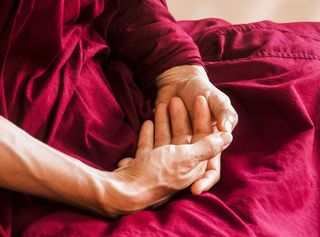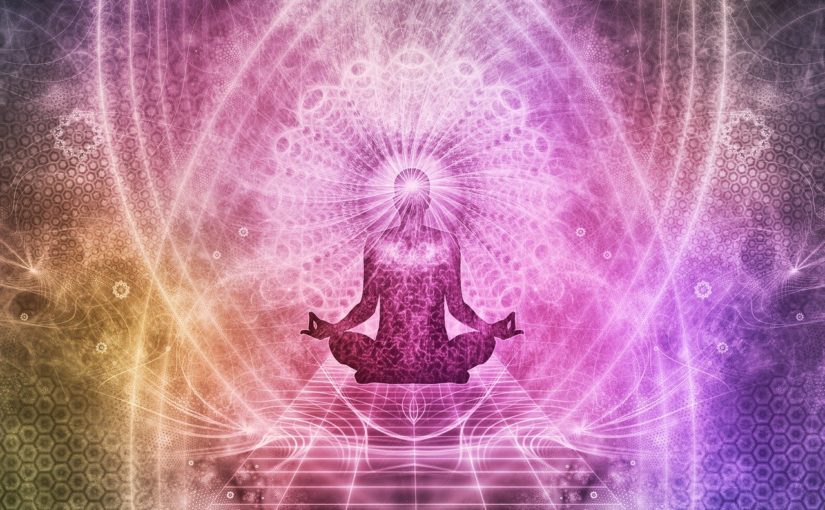Lovingly borrowed from Christopher Bergland’s article in Psychology Today:
Social distancing and “shelter-in-place” mandates can make life during a pandemic seem monastic. Has COVID-19 and the subsequent “stay-at-home” advisories made you feel like a monk?

If so, this period of forced monasticism is a perfect time to make daily meditation a part of your routine. Also, if you have kids who are cooped up at home and suffering from cabin fever, teaching children how to meditate can have many short-term, as well as lifelong benefits.
What are some benefits of meditation? In addition to the immediate benefits of meditation, such as reducing stress, cultivating equanimity, and calming your nervous system, a new longitudinal MRI case study of a Buddhist monk suggests that daily meditation may slow down brain aging over time. The findings (Adluru et al., 2020) of this “BrainAGE and Regional Volumetric Analysis of a Buddhist Monk” were recently published in Neurocase.
A loss of gray matter brain volume accompanies typical aging. A few years ago, another BrainAGE study (Luders, Cherbuin & Gaser, 2016) found that by age 50, the brains of long-term meditation practitioners were, on average, 7.5 years younger than non-meditator controls.
“Altogether, these findings seem to suggest that meditation is beneficial for brain preservation, effectively protecting against age-related atrophy with a consistently slower rate of brain aging throughout life,” Eileen Luders of the UCLA Center for Neurobiology of Stress and Resilience and her co-authors concluded.

For the most recently published (2020) BrainAGE case study on how meditation may slow brain aging, researchers from Harvard Medical School and the Center for Healthy Minds at the University of Wisconsin-Madison spent 14 years observing a Buddhist monk from Tibet. During this same period, the researchers also conducted MRI brain scans on a control group of 105 age-matched adults who didn’t meditate regularly.
Who’s the monk? Yongey Mingyur Rinpoche (a.k.a., YMR) is a 41-year-old Buddhist monk who’s lived a monastic life since he was a teenager and has practiced meditation along with “wandering retreats” throughout his life. Over the past 14 years, YMR had his brain scanned four times in an MRI.
As a child, YMR experienced crippling anxiety and panic attacks. Luckily, his father practiced Buddhist meditation and taught Yongey Mingyur Rinpoche specific ways to cope with his panic via meditation when he was 9 years old.
In 2018, YMR gave a public talk, “Meditation and Going Beyond Mindfulness: A Secular Perspective,” at the London School of Economics. During this talk, Rinpoche recounts how his father taught him a technique of welcoming (and quelling) panic during his meditation practice when he was a kid:
At first, when my panic came, I said, “Hello, panic. Get out! I’m meditating.” But, the panic would become stronger and louder. I was disappointed. I thought meditation was supposed to help my panic, but it didn’t help. So, I went back to my father and told him about my disappointing experience with meditation. My father said, “Don’t say ‘Get out!’ to panic. You must welcome the panic. During meditation, panic doesn’t have to become an obstacle. Panic is okay; no panic is okay.” I thought “Wow, interesting.” So then I changed my style of meditation a little bit. I began to say “welcome” to my panic.
Whenever YMR experienced a sense of panic while meditating, he learned to say, “Hello, panic. Welcome.” As he half-jokingly sums up these dynamics: “Me and my panic became good friends.”
Interestingly, once Yongey Mingyur Rinpoche was no longer afraid of the panic and accepted it, he stopped having panic attacks. “Panic said goodbye and my panic was gone. But, I learned a lot from my panic. Today, I’m here because of my panic. And I really believe this meditation technique changed my life.”
One key aspect of how YMR practices and teaches meditation centers around “mindful acceptance.” Earlier this year, an fMRI brain imaging study (Kober et al., 2020) by researchers from Columbia, Dartmouth, and Yale reported that individuals with minimal meditation experience can learn how to moderate their brains’ response to painful experiences after a single, 20-minute course on mindful acceptance. The researchers describe this as a “Let It Be” approach to emotion regulation.
In this YouTube video, YMR shares some of his meditation “secrets” with a general audience:
The clip above is cued to begin at 36:46 which is a particularly insightful section of the full-length (1:44:40) video—which gives detailed advice on how to practice mindful acceptance during meditation. As YMR explains:
So, once you recognize and try to maintain awareness, you will have a lot of discovery within yourself. The awareness will open up… Once your awareness opens up, you don’t need to block emotion. It’s not necessary. Because, even if you achieve thoughtless or a more emotionless meditation, it is not [necessarily] a “good” meditation. You may become a little bit like a zombie. Maybe a happy zombie [laughter from audience]… So, therefore, during what we call the “real” meditation you don’t need to meditate, you just connect with your own awareness. Recognize awareness and maintain that recognition.
Don’t worry that you don’t know how to meditate. Be yourself, don’t worry. You don’t have to pretend to be somebody or someone. Just be yourself. Be free. If you want to cry, you can cry. If you want to laugh, you can laugh. If you cannot find awareness, that is also awareness. So, there’s no need to worry about whether you’re doing it right or wrong if you maintain your recognition of awareness. Be free and be yourself.
Nagesh Adluru of the Center for Healthy Minds at the University of Wisconsin-Madison wondered if the decades-long practice of this meditation technique might have an impact on the structure and age of YMR’s brain.
“YMR’s brain-aging rate appeared slower than that of controls suggesting early maturation and delayed aging. At 41 years, his brain resembled that of a 33-year-old,” Adluru et al. write. “Specific regional changes did not differentiate YMR from controls, suggesting that the brain-aging differences may arise from coordinated changes spread throughout the gray matter.”
Hopefully, if you’re not a long-term meditation practitioner, these MRI-based BrainAGE findings and the lessons from YMR will inspire you to make meditation and mindful acceptance a part of your daily routine.
References
Nagesh Adluru, Cole H. Korponay, Derek L. Norton, Robin I. Goldman, and Richard J. Davidson. “BrainAGE and Regional Volumetric Analysis of a Buddhist Monk: A Longitudinal MRI Case Study” Neurocase (First published online: February 26, 2020) DOI: 10.1080/13554794.2020.1731553
Katja Franke and Christian Gaser. “Ten Years of BrainAGE as a Neuroimaging Biomarker of Brain Aging: What Insights Have We Gained?” NeuroImage (First published: August 14, 2019) DOI: 10.3389/fneur.2019.00789
Eileen Luders, Nicolas Cherbuin, Christian Gaser. “Estimating Brain Age Using High-Resolution Pattern Recognition: Younger Brains in Long-Term Meditation Practitioners.” NeuroImage (First published online: April 11, 2016) DOI: 10.1016/j.neuroimage.2016.04.007
Hedy Kober, Jason Buhle, Jochen Weber, Kevin N Ochsner, Tor D. Wager. “Let It Be: Mindful-Acceptance Down-Regulates Pain and Negative Emotion.” Social Cognitive and Affective Neuroscience (First published: January 27, 2020) DOI: 10.1093/scan/nsz104

